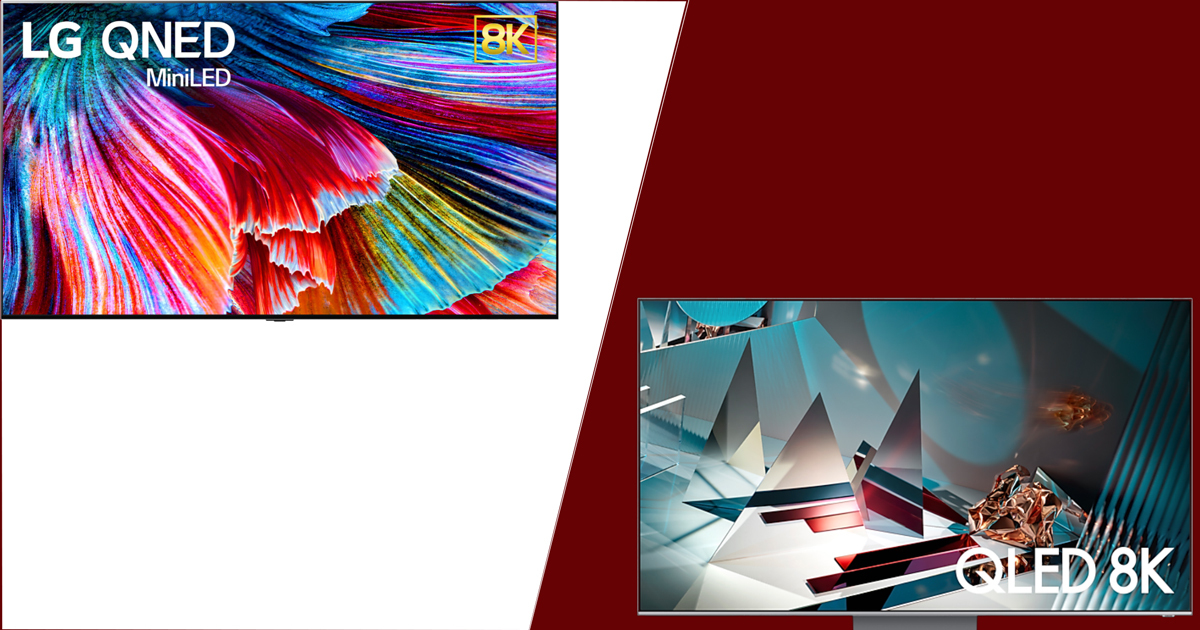QD-OLEDs are still conspicuously missing, but LG introduced the first QNED mini LED TV range at CES 2021. Samsung, on the other hand, is matching up with Neo QLED TVs this year that have mini LED backlight with signinicantly more dimming zones.
Before we dive into details and tell these different terms apart, let’s address some confusion:
LG QNED is not the same as Samsung QNED
LG using QNED moniker for its TVs is a bit difficult to swallow because QNED technology has always been associated with Samsung Displays.
The thing is, LG’s QNED is Quantum-Dot NanoCell LED and functions similarly to Samsung’s QLED or rather Neo QLED. Both of these are mini LED displays. Pixels are not self emissive and the display relies on a backlight like all conventional transmissive LCD LED TVs. LG uses Quantum Dot converters between the LCD substrate and backlight and a regular color filter ahead of the LCD screen.
Samsung’s QNED, on the other hand, is Quantum Nanorod Emitting Diode and is a self-emissive technology (like OLED) that will eventually succeed the QD-OLED displays. Samsung’s QNED is next-to-next gen technology and is still in the early R&D phase. In fact, even QD-OLED that QNED is supposed to succeed is still in the pre-production stage.
If you are not familiar with the basic structure of a LED or OLED TV, we recommend that you go through the guide linked below or move to the next section where we will elaborate on QNED and QLED in more detail.
Check: QD-OLED vs OLED vs QLED vs Mini-LED TVs: What’s the difference?
QNED VS QLED TVs: Display Technology
LG QNED and Samsung QLED both depend on a backlight for illumination. QNED has a mini LED backlight, which is to say that there are many tiny LEDs comprising the backlight.
These LEDs can be individually turned off with precission when portraying dark areas in an image and having more LEDs allows for more such ‘dimming zones’. Which in turn leads to better contrast.
LG’s QNED TV backlight comprises of 30,000 mini LEDs resulting in 2500 dimming zones and 1,000,000:1 contrast ratio.
Next to the backlight, LG uses both Quantum Dot Enhancement Film (QDEF) and LG’s proprietary Nanocell technology.
Both LG and Samsung source Quantum Dot Enhancement Film from Nanosys. This Quantum Dot layer helps achieve pure white light from the backlight that eventually helps realize wider color gamuts.
LG’s Nanocell tech is used to enhance the performance of IPS LCD. LG adds nano particles that can absorb unwanted light wavelengths for purer reds and greens, resulting in wider color gamuts along with wide viewing angles from use of IPS LCD substrate.
Samsung doesn’t use mini LED backlight for its QLED but does so for its Neo QLED TVs launched in 2021. It claims that the size of these mini LEDs is 1/40 the size of conventional LEDs!
Unlike LG, Samsung doesn’t use IPS LCD for its TVs. Instead, the company backs VA or Vertically Aligned LCD that is known to deliver better contrast than IPS LCD, but has relatively narrower viewing angles.
LG QNED VS Samsung Neo QLED TVs: Resolution and HDR
LG’s QNED TVs and Samsung’s Neo QLED TVs will be available in both 4K and 8K resolution. LG includes support for HDR10, HLG and Dolby Vision HDR. Samsung stubornly refuses to back Dolby Vision HDR and is still siding with HDR10/10+, HLG and HDR 10+ Adaptive (which fine tunes HDR 10+ for viewing in a bright lit room).
Both Samsung and LG will include HDMI 2.1 connectivity, up to 120Hz refresh rates, and Nvdia G-sync Support in their Neo QLED and QNED range.
To sum it up, LG QNED and Samsung Neo QLED are both transmissive display technologies that rely on mini-LED backlight and use a Quantum Dot layer to enhance whites from the backlight. Self-emmisive technologies like OLED and QD-OLED will still lead with higher contrast and faster response time.
